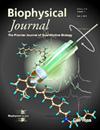Mechanistic basis for enhanced strigolactone sensitivity in KAI2 triple mutant
IF 3.2
3区 生物学
Q2 BIOPHYSICS
引用次数: 0
Abstract
KAI2三重突变体增强独角麦内酯敏感性的机制基础
刺草是一种寄生杂草,每年摧毁价值数十亿美元的主要作物。它的快速增殖源于其代谢单丁内酯(SLs)的能力增强,单丁内酯是一种指导根分支和芽生长的植物激素。Striga的SL受体ShHTL7与主要作物karrikin受体karrikin insensitive 2 (KAI2)的相似性高于与SL受体D14的相似性,尽管拟南芥(Arabidopsis thaliana)等植物中的KAI2变异对SL的敏感性最低。最近的研究表明,HTL7残基的少量点突变可以使SL对AtKAI2敏感。在这里,我们通过全原子、长时间尺度的分子动力学模拟分析了野生型AtKAI2和sl敏感突变体Var64,以确定这些突变在分子水平上对受体功能的影响。我们证明突变使SL结合稳定约2 kcal/mol。它们还导致平均口袋体积加倍,并消除了对某些口袋构象排列的依赖。虽然与野生型相比,突变体中某些非结合性sl受体相互作用的概率增加了,但结合率也增加了10倍。所有这些变化都解释了突变体KAI2对SL敏感性的增加,并提示了宿主作物SL受体功能增强的机制。
本文章由计算机程序翻译,如有差异,请以英文原文为准。
求助全文
约1分钟内获得全文
求助全文
来源期刊

Biophysical journal
生物-生物物理
CiteScore
6.10
自引率
5.90%
发文量
3090
审稿时长
2 months
期刊介绍:
BJ publishes original articles, letters, and perspectives on important problems in modern biophysics. The papers should be written so as to be of interest to a broad community of biophysicists. BJ welcomes experimental studies that employ quantitative physical approaches for the study of biological systems, including or spanning scales from molecule to whole organism. Experimental studies of a purely descriptive or phenomenological nature, with no theoretical or mechanistic underpinning, are not appropriate for publication in BJ. Theoretical studies should offer new insights into the understanding ofexperimental results or suggest new experimentally testable hypotheses. Articles reporting significant methodological or technological advances, which have potential to open new areas of biophysical investigation, are also suitable for publication in BJ. Papers describing improvements in accuracy or speed of existing methods or extra detail within methods described previously are not suitable for BJ.
 求助内容:
求助内容: 应助结果提醒方式:
应助结果提醒方式:


